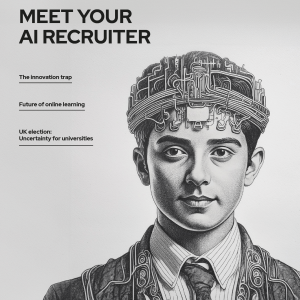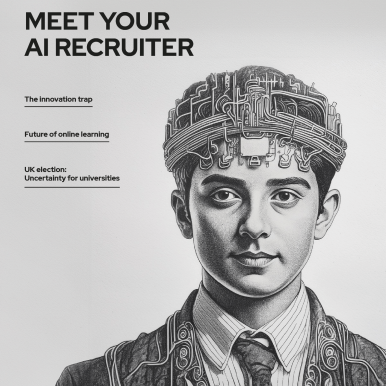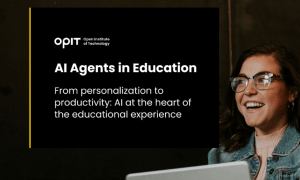

Source:
Debating the merits of human recruiters vs. AI chatbots
By Chloë Lane
Less than two years have passed since ChatGPT was first released to the public. For many, OpenAI’s chatbot was their first real introduction to AI technology.
Now, in 2024, AI is being used regularly in many different industries and is continuing to grow. The global market for AI in education is expected to reach $6 billion by 2025.
In higher education specifically, one of the ways it is used is in helping students decide where to study. Over a third of students surveyed in a recent QS report said that Generative AI has influenced their choice of course, university and career.
When considering a study destination, applicants understandably have plenty of questions for students and faculty at their institution of interest. However, these questions can often go unanswered for a long time if asked outside of standard helpdesk hours. This is where AI chatbots come in.
AI alone is not enough to attract the best candidates
At the Open Institute of Technology (OPIT), an online institution which specialises in tech degrees, students undoubtedly prefer to interact with real tutors and appreciate the opportunity to meet professors and classmates face-to-face, even in a virtual setting. But when it comes to student recruitment, Greta Maiocchi, Head of Marketing and Admissions, can certainly see the appeal of an AI chatbot.
“AI chatbots can provide immediate answers at any time of day or night, which can be very convenient for students with busy or irregular schedules,” she says. “They can efficiently handle routine inquiries and provide instant information, but they do not replace the depth that human interactions offer.”
She raises the point that while AI chatbots can offer quick responses, they are limited by the data used to train them and might not fully address specific or nuanced queries. Besides, the empathy and personalised support provided by human interactions are crucial and cannot be easily replaced.
“Human touch fosters a sense of belonging and support that is essential for a fulfilling educational experience,” she admits.
A combination of AI chatbots and human interactions would therefore be the most effective approach for student recruitment, Maiocchi believes. This approach, she says, will maximise efficiency while maintaining the personal touch that students value.
Transparency is a key factor to consider, adds Maiocchi. Students should always be informed when they are interacting with an AI chatbot, ensuring that they know when to expect automated responses and when to seek more personalised assistance.
“Recruitment offices can restructure to maximise efficiency by utilising AI for routine tasks but should always ensure that human staff are available to offer the necessary depth and personalised touch that prospective students often seek,” she advises.
“Ensuring a human presence, especially in the later stages of the recruitment process, is crucial for building trust and fostering a positive experience.”
Read the full article below:
Related posts

Source:
- Times of Malta, published on September 18th, 2025
4 min read
The gathering brought together academics and technology leaders from prominent European Institutions, such as Instituto de Empresa (IE University), OPIT itself and the Royal College of Arts, to explore how artificial intelligence is reshaping the university experience.
The OPIT AI Copilot has been trained on the institute’s complete academic archive, a collection created over the past three years that includes 131 courses, more than 3,500 hours of recorded lectures, 7,500 study resources, 320 certified assessments, and thousands of exercises and original learning documents.
Unlike generic AI tools, the Copilot is deeply integrated with OPIT’s learning management system, allowing it to track each student’s progress and provide tailored support.
This integration means the assistant can reference relevant sources within the learning environment, adapt to the student’s stage of study, and ensure that unreleased course content remains inaccessible.
A mobile app is also scheduled for release this autumn, that will allow students to download exercise and access other tools.
During examinations, the Copilot automatically switches to what the institute calls an “anti-cheating mode”, restricting itself to general research support rather than providing direct answers.
For OPIT’s international community of 500 students from nearly 100 countries, many of whom balance studies with full-time work, the ability to access personalised assistance at any time of day is a key advantage.
“Eighty-five per cent of students are already using large language models in some way to study,” said OPIT founder and director Riccardo Ocleppo. “We wanted to go further by creating a solution tailored to our own community, reflecting the real experiences of remote learners and working professionals.”
Tool aims to cut correction time by 30%
The Copilot will also reduce administrative burdens for faculty. It can help grade assignments, generate new educational materials, and create rubrics that allow teachers to cut correction time by as much as 30 per cent.
According to OPIT, this will free up staff to dedicate more time to teaching and direct student engagement.
At the Milan event, Rector Francesco Profumo underlined the broader implications of AI in higher education. “We are in the midst of a deep transformation, where AI is no longer just a tool: it is an environment that radically changes how we learn, teach, and create,” he said.
“But it is not a shortcut. It is a cultural, ethical, and pedagogical challenge, and to meet it we must have the courage to rethink traditional models and build bridges between human and artificial intelligence.”
OPIT was joined on stage by representatives from other leading institutions, including Danielle Barrios O’Neill of the Royal College of Art, who spoke about the role of AI in art and creativity, and Francisco Machin of IE University, who discussed applications in business and management education.
OPIT student Asya Mantovani, also employed at a leading technology and consulting firm in Italy, gave a first-hand account of balancing professional life with online study.
The assistant has been in development for the past eight months, involving a team of OPIT professors, researchers, and engineers.
Ocleppo stressed that OPIT intends to make its AI innovations available beyond its own institution. “We want to put technology at the service of higher education,” he said.
“Our goal is to develop solutions not only for our own students, but also to share with global institutions eager to innovate the learning experience in a future that is approaching very quickly.”

From personalization to productivity: AI at the heart of the educational experience.
Click this link to read and download the e-book.
At its core, teaching is a simple endeavour. The experienced and learned pass on their knowledge and wisdom to new generations. Nothing has changed in that regard. What has changed is how new technologies emerge to facilitate that passing on of knowledge. The printing press, computers, the internet – all have transformed how educators teach and how students learn.
Artificial intelligence (AI) is the next game-changer in the educational space.
Specifically, AI agents have emerged as tools that utilize all of AI’s core strengths, such as data gathering and analysis, pattern identification, and information condensing. Those strengths have been refined, first into simple chatbots capable of providing answers, and now into agents capable of adapting how they learn and adjusting to the environment in which they’re placed. This adaptability, in particular, makes AI agents vital in the educational realm.
The reasons why are simple. AI agents can collect, analyse, and condense massive amounts of educational material across multiple subject areas. More importantly, they can deliver that information to students while observing how the students engage with the material presented. Those observations open the door for tweaks. An AI agent learns alongside their student. Only, the agent’s learning focuses on how it can adapt its delivery to account for a student’s strengths, weaknesses, interests, and existing knowledge.
Think of an AI agent like having a tutor – one who eschews set lesson plans in favour of an adaptive approach designed and tweaked constantly for each specific student.
In this eBook, the Open Institute of Technology (OPIT) will take you on a journey through the world of AI agents as they pertain to education. You will learn what these agents are, how they work, and what they’re capable of achieving in the educational sector. We also explore best practices and key approaches, focusing on how educators can use AI agents to the benefit of their students. Finally, we will discuss other AI tools that both complement and enhance an AI agent’s capabilities, ensuring you deliver the best possible educational experience to your students.
Have questions?
Visit our FAQ page or get in touch with us!
Write us at +39 335 576 0263
Get in touch at hello@opit.com
Talk to one of our Study Advisors
We are international
We can speak in:
